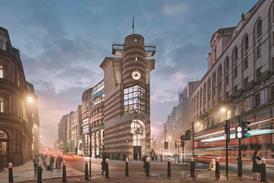- Home
- Intelligence for Architects
- Subscribe
- Jobs
- Events

2025 events calendar Explore now 
Keep up to date
Find out more
- Programmes
- CPD
- More from navigation items
St Giles Circus by Orms and Ian Chalk Architects: the rebirth of Tin Pan Alley

Orms seeks to combine the heyday of West End art deco with historic conservation and careful urban stitching in a new music-centred district at the heart of London, writes Ben Flatman
The slightly seedy character and low rents of central London’s St Giles area attracted music publishers to Denmark Street during the 20th century. London’s “Tin Pan Alley” became home to the likes of NME and Melody Maker and its musical instrument shops and live music venues gave it a reputation as the centre of London’s pop music scene.
By 2014, however, a blue plaque had been installed, marking the supposed death of the street’s musical associations.
Now St Giles Circus, a massive new development designed by Orms and Ian Chalk Architects for Consolidated Developments and Outernet Global, seeks to salvage the area’s reputation for music-making and live performance. The scheme consists of most of Denmark Street and its 17th-century townhouses, as well as the massive new black and gold Outernet buildings.
…
This content is available to registered users | Already registered?Login here
You are not currently logged in.
To continue reading this story, sign up for free guest access
Existing Subscriber? LOGIN
REGISTER for free access on selected stories and sign up for email alerts. You get:
- Up to the minute architecture news from around the UK
- Breaking, daily and weekly e-newsletters
Subscribe to Building Design and you will benefit from:

- Unlimited news
- Reviews of the latest buildings from all corners of the world
- Technical studies
- Full access to all our online archives
- PLUS you will receive a digital copy of WA100 worth over £45
Subscribe now for unlimited access.






